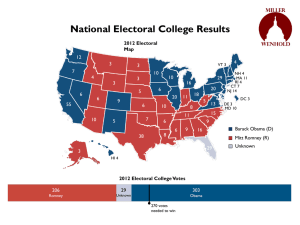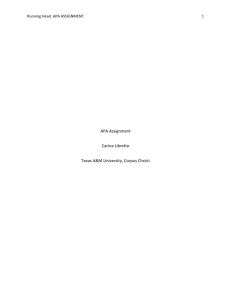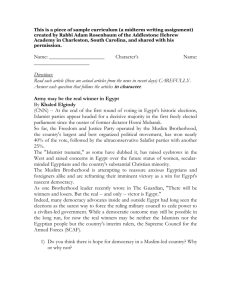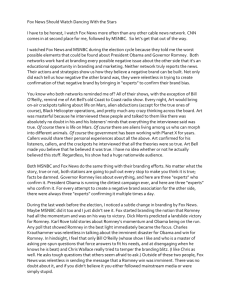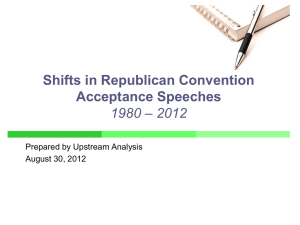Module 1.1: IT Auditing THE NATURE OF AUDITING THE NATURE
advertisement
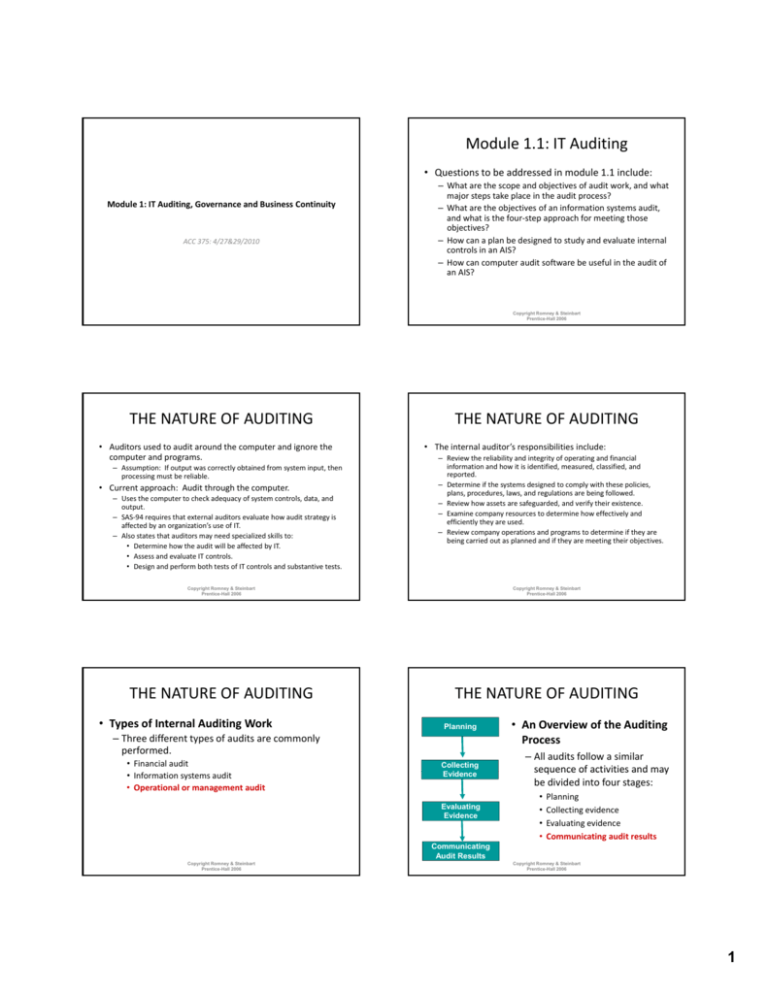
Module 1.1: IT Auditing • Questions to be addressed in module 1.1 include: Module 1: IT Auditing, Governance and Business Continuity ACC 375: 4/27&29/2010 – What are the scope and objectives of audit work, and what major steps take place in the audit process? – What are the objectives of an information systems audit, and what is the four‐step approach for meeting those p pp g objectives? – How can a plan be designed to study and evaluate internal controls in an AIS? – How can computer audit software be useful in the audit of an AIS? Copyright Romney & Steinbart Prentice-Hall 2006 THE NATURE OF AUDITING • Auditors used to audit around the computer and ignore the computer and programs. – Assumption: If output was correctly obtained from system input, then processing must be reliable. • Current approach: Audit through the computer. – U Uses the computer to check adequacy of system controls, data, and h h k d f l d d output. – SAS‐94 requires that external auditors evaluate how audit strategy is affected by an organization’s use of IT. – Also states that auditors may need specialized skills to: • Determine how the audit will be affected by IT. • Assess and evaluate IT controls. • Design and perform both tests of IT controls and substantive tests. THE NATURE OF AUDITING • The internal auditor’s responsibilities include: – Review the reliability and integrity of operating and financial information and how it is identified, measured, classified, and reported. – Determine if the systems designed to comply with these policies, p plans, procedures, laws, and regulations are being followed. ,p , , g g – Review how assets are safeguarded, and verify their existence. – Examine company resources to determine how effectively and efficiently they are used. – Review company operations and programs to determine if they are being carried out as planned and if they are meeting their objectives. Copyright Romney & Steinbart Prentice-Hall 2006 Copyright Romney & Steinbart Prentice-Hall 2006 THE NATURE OF AUDITING THE NATURE OF AUDITING • Types of Internal Auditing Work Planning – Three different types of audits are commonly performed. • Financial audit • Information systems audit • Operational or management audit Collecting E id Evidence Evaluating Evidence • An Overview of the Auditing Process – All audits follow a similar sequence of activities and may sequence of activities and may be divided into four stages: • • • • Planning Collecting evidence Evaluating evidence Communicating audit results Communicating Audit Results Copyright Romney & Steinbart Prentice-Hall 2006 Copyright Romney & Steinbart Prentice-Hall 2006 1 THE NATURE OF AUDITING Planning Collecting E id Evidence Evaluating Evidence • Audit Planning – Purpose: Determine why, how, when, and by whom the audit will be performed. – The first step in audit planning is to establish the scope and objectives of the audit. – An audit team with the necessary experience An audit team with the necessary experience and expertise is formed. – Team members become familiar with the auditee by: • Conferring with supervisory and operating personnel; • Reviewing system documentation; and • Reviewing findings of prior audits. THE NATURE OF AUDITING • The audit should be planned so that the greatest amount of audit work focuses on areas with the highest risk factors. • There are three types of risk when conducting There are three types of risk when conducting an audit: – Inherent risk – Control risk – Detection risk Communicating Audit Results Copyright Romney & Steinbart Prentice-Hall 2006 Copyright Romney & Steinbart Prentice-Hall 2006 THE NATURE OF AUDITING THE NATURE OF AUDITING Planning Collecting E id Evidence • Collection of Audit Evidence – Much audit effort is spent collecting evidence collecting evidence. Evaluating Evidence • Collection of Audit Evidence – The following are among the most commonly used evidence collection methods: • • • • • • • • Observation Review of documentation Discussions Physical examination Confirmation Re‐performance Vouching Analytical review Communicating Audit Results Copyright Romney & Steinbart Prentice-Hall 2006 Copyright Romney & Steinbart Prentice-Hall 2006 THE NATURE OF AUDITING THE NATURE OF AUDITING Planning Collecting E id Evidence Evaluating Evidence • Evaluation of Audit Evidence – The auditor evaluates the evidence gathered in light of the specific audit objective and decides if it supports a favorable or unfavorable conclusion. – If inconclusive, the auditor plans and , p executes additional procedures until sufficient evidence is obtained. – Two important factors when deciding how much audit work is necessary and in evaluating audit evidence are: • Materiality • Reasonable assurance Communicating Audit Results Planning Collecting E id Evidence Evaluating Evidence Communicating Audit Results Copyright Romney & Steinbart Prentice-Hall 2006 • Communication of audit results – The auditor prepares a written (and sometimes oral) report summarizing audit findings and recommendations, with references to supporting evidence in the working papers. – Report is presented to: • Management • The audit committee • The board of directors • Other appropriate parties – After results are communicated, auditors often perform a follow‐up study to see if recommendations have been implemented. Copyright Romney & Steinbart Prentice-Hall 2006 2 THE NATURE OF AUDITING • The Risk‐Based Audit Approach – A risk‐based audit approach is a four‐step approach to internal control evaluation that provides a logical framework for carrying out an audit. Steps are: • Determine the threats (errors and irregularities) facing the AIS. • Identify control procedures implemented to minimize each threat by preventing or detecting such errors and irregularities. • Evaluate the control procedures. • Evaluate weaknesses (errors and irregularities not covered by control procedures) to determine their effect on the nature, timing, or extent of auditing procedures and client suggestions. Copyright Romney & Steinbart Prentice-Hall 2006 • The purpose of an information systems audit is to review and evaluate the internal controls that protect the system. • When performing an information system audit, auditors should ascertain that the following objectives are met: – Security Security provisions protect computer equipment, programs, provisions protect computer equipment programs communications, and data from unauthorized access, modification, or destruction. – Program development and acquisition are performed in accordance with management’s general and specific authorization. – Program modifications have management’s authorization and approval. Copyright Romney & Steinbart Prentice-Hall 2006 IS COMPONENTS AND AUDIT OBJECTIVES Objective 1: Overall Security Objective 5: Source Data Source Data OBJECTIVE 1: OVERALL SECURITY • Types of security errors and fraud faced by companies: Data Entry Objective 2: Program Development And Acquisition INFORMATION SYSTEMS AUDITS – Accidental or intentional damage to system assets. – Unauthorized access, disclosure, or modification of data and programs. – Theft. – Interruption of crucial business activities. Source Data Processing Files Programs Output Objective 3: Program Modification Objective 4: Computer Processing Copyright Romney & Steinbart Prentice-Hall 2006 Objective 6: Data Files OBJECTIVE 1: OVERALL SECURITY • Control procedures to minimize security errors and fraud: – – – – – – – Developing an information security/protection plan. Restricting physical and logical access. Encrypting data. Protecting against viruses. Implementing firewalls. p g Instituting data transmission controls. Preventing and recovering from system failures or disasters, including: • Designing fault‐tolerant systems. • Preventive maintenance. • Backup and recovery procedures. • Disaster recovery plans. • Adequate insurance. Copyright Romney & Steinbart Prentice-Hall 2006 Copyright Romney & Steinbart Prentice-Hall 2006 OBJECTIVE 2: PROGRAM DEVELOPMENT AND ACQUISITION • Types of errors and fraud: – Two things can go wrong in program development: • Inadvertent Inadvertent errors due to careless programming or errors due to careless programming or misunderstanding specifications; or • Deliberate insertion of unauthorized instructions into the programs. Copyright Romney & Steinbart Prentice-Hall 2006 3 OBJECTIVE 2: PROGRAM DEVELOPMENT AND ACQUISITION • Control procedures: – The preceding problems can be controlled by requiring: • Management and user authorization and approval Management and user authorization and approval • Thorough testing • Proper documentation OBJECTIVE 3: PROGRAM MODIFICATION • Control Procedures – When a program change is submitted for approval, a list of all required updates should be compiled by management and program users. – Changes should be thoroughly tested and documented. – During the change process, the developmental version of the program must be kept separate from the production version must be kept separate from the production version. – When the amended program has received final approval, it should replace the production version. – Changes should be implemented by personnel independent of users or programmers. – Logical access controls should be employed at all times. Copyright Romney & Steinbart Prentice-Hall 2006 Copyright Romney & Steinbart Prentice-Hall 2006 OBJECTIVE 3: PROGRAM MODIFICATION OBJECTIVE 3: PROGRAM MODIFICATION – To test for unauthorized program changes, auditors can use a source code comparison program to compare the current version of the program with the original source code. – Two additional techniques detect unauthorized program changes: • Any unauthorized differences should result in an investigation. • If the difference represents an authorized change, the auditor can refer to the program change specifications to ensure that the changes were authorized and correctly incorporated. • Reprocessing – On a surprise basis, the auditor uses a verified copy of the source code to reprocess data and compare that output with source code to reprocess data and compare that output with the company’s data. – Discrepancies are investigated. • Parallel simulation – Similar to reprocessing except that the auditor writes his own program instead of using verified source code. – Can be used to test a program during the implementation process. Copyright Romney & Steinbart Prentice-Hall 2006 Copyright Romney & Steinbart Prentice-Hall 2006 OBJECTIVE 4: COMPUTER PROCESSING OBJECTIVE 4: COMPUTER PROCESSING • Processing Test Data – Involves testing a program by processing a hypothetical series of valid and invalid transactions. – The program should: • Process all the valid transactions correctly. • Identify and reject the invalid ones. Id tif d j t th i lid – All logic paths should be checked for proper functioning by one or more test transactions, including: • • • • • Records with missing data Fields containing unreasonably large amounts Invalid account numbers or processing codes Non‐numeric data in numeric fields Records out of sequence Copyright Romney & Steinbart Prentice-Hall 2006 • The following resources are helpful when preparing test data: – A listing of actual transactions – The transactions that the programmer used to test the program – A test data generator program, which automatically prepares test data based on program specifications Copyright Romney & Steinbart Prentice-Hall 2006 4 OBJECTIVE 4: COMPUTER PROCESSING • Concurrent audit techniques – Millions of dollars of transactions can be processed in an online system without leaving a satisfactory audit trail. – In such cases, evidence gathered after data processing is insufficient for audit purposes. – Also, because many online systems process transactions Al b li t t ti continuously, it is difficult or impossible to stop the system to perform audit tests. – Consequently, auditors use concurrent audit techniques to continually monitor the system and collect audit evidence while live data are processed during regular operating hours. OBJECTIVE 4: COMPUTER PROCESSING • Concurrent audit techniques use embedded audit modules. – These are segments of program code that: • Perform audit functions; Perform audit functions; • Report test results to the auditor; and • Store collected evidence for auditor review. – Are time‐consuming and difficult to use, but less so if incorporated when programs are developed. Copyright Romney & Steinbart Prentice-Hall 2006 Copyright Romney & Steinbart Prentice-Hall 2006 OBJECTIVE 4: COMPUTER PROCESSING OBJECTIVE 4: COMPUTER PROCESSING • An ITF technique places a small set of fictitious records in the master files: – May represent a fictitious division, department, office customer or supplier office, customer, or supplier. – Processing test transactions to update these dummy records will not affect actual records. – Because real and fictitious transactions are processed together, company employees don’t know the testing is taking place. • The snapshot technique examines the way transactions are processed. – Selected transactions are marked with a special code that triggers the snapshot process. – Audit modules in the program record these transactions and their master file records before and after processing. – The selected data are recorded in a special file and reviewed by the auditor to verify that all processing steps were properly executed. Copyright Romney & Steinbart Prentice-Hall 2006 Copyright Romney & Steinbart Prentice-Hall 2006 OBJECTIVE 4: COMPUTER PROCESSING OBJECTIVE 4: COMPUTER PROCESSING • The system control audit review file (SCARF) uses embedded audit modules to continuously monitor transaction activity and collect data on transactions with special audit significance. • Data recorded in a SCARF file or audit log include transactions that: • Audit hooks are audit routines that flag suspicious transactions. • Example: State Farm Life Insurance looking for policyholders who change their name or address and then subsequently withdraw funds. • When audit hooks are used, auditors can be informed of questionable transactions as they occur via real‐time notification, which displays a message on the auditor’s terminal. – – – – Exceed a specified dollar limit; Involve inactive accounts; Deviate from company policy; or Contain write‐downs of asset values. • Periodically the auditor: – Receives a printout of SCARF transactions; – Looks for questionable transactions among them; and – Investigates. Copyright Romney & Steinbart Prentice-Hall 2006 Copyright Romney & Steinbart Prentice-Hall 2006 5 OBJECTIVE 4: COMPUTER PROCESSING • Continuous and intermittent simulation (CIS) embeds an audit module in a database management system. • The module examines all transactions that update the DBMS using criteria similar to those of SCARF. • When a transaction has audit significance, the module: – Processes the data independently (similar to parallel simulation); – Records the results; – Compares results with those obtained by the DBMS. • If there are discrepancies, details are written to an audit log for subsequent investigation. • Serious discrepancies may prevent the DBMS from executing the update. OBJECTIVE 4: COMPUTER PROCESSING • Analysis of Program Logic – If an auditor suspects that a particular program contains unauthorized code or serious errors, a detailed analysis of the program logic may be necessary. – Done only as a last resort because: y • It’s time‐consuming • Requires programming language proficiency – To perform the analysis, auditors reference: • Program flowcharts • Program documentation • Program source code. Copyright Romney & Steinbart Prentice-Hall 2006 Copyright Romney & Steinbart Prentice-Hall 2006 OBJECTIVE 4: COMPUTER PROCESSING OBJECTIVE 5: SOURCE DATA • The following software packages can help: – Automated flowcharting programs – Automated decision table programs – Scanning routines Scanning routines – Mapping programs – Program tracing Record Name Employee Weekly Time Report Input Controls Financial totals Hash totals Record counts Cross-footing balance Key verification Visual inspection Check digit verification Pre-numbered forms Turnaround document Edit program Sequence check Field check Sign check Validity check Limit check Reasonableness test Redundant data check Completeness test Overflow procedure Other – Observe and evaluate data control department operations and specific data control procedures – Verify proper maintenance and use of data control log – Evaluate how items recorded in the error log are handled Evaluate how items recorded in the error log are handled – Examine samples of accounting source data for proper authorization – Reconcile a sample of batch totals and follow up on discrepancies – Trace disposition of a sample of errors flagged by data edit routines Copyright Romney & Steinbart Prentice-Hall 2006 Em pl oy ee La Nu st m Na be m De r e pa rtm en Tr an tN sa um ct be W io ee n r Co k En de Re di ng gu (D la rH at Ov e) ou er rs tim e Ho ur s Copyright Romney & Steinbart Prentice-Hall 2006 • Audit Procedures: Tests of Controls Field Names OBJECTIVE 5: SOURCE DATA Comments Yes No All fields No No Yes Copyright Romney & Steinbart Prentice-Hall 2006 • Auditors should ensure the data control function: – Is independent of other functions – Maintains a data control log Maintains a data control log – Handles errors – Ensures overall efficiency of operations • Usually not feasible for small businesses and PC installations to have an independent data control function. Copyright Romney & Steinbart Prentice-Hall 2006 6 OBJECTIVE 5: SOURCE DATA • To compensate, user department controls must be stronger over: – – – – – Data preparation Batch control totals Edit programs Edit programs Physical and logical access restrictions Error handling procedures • These procedures should be the focus of the auditor’s systems review and tests of controls when there is no independent data control function. OBJECTIVE 6: DATA FILES • The sixth objective concerns the accuracy, integrity, and security of data stored in machine‐readable files. • Data storage risks include: – Unauthorized modification of data – Destruction of data – Disclosure of data • Many of the controls discussed in Chapter 8 protect against the preceding risks. • If file controls are seriously deficient, especially with respect to access or backup and recovery, the auditor should strongly recommend they be rectified. Copyright Romney & Steinbart Prentice-Hall 2006 Copyright Romney & Steinbart Prentice-Hall 2006 OBJECTIVE 6: DATA FILES OBJECTIVE 6: DATA FILES • Auditing‐by‐objectives is a comprehensive, systematic, and effective means of evaluating internal controls in an AIS. – Can be implemented using an audit procedures checklist for each objective. – Should help the auditor reach a separate conclusion for each objective and suggest compensating controls. • Compensating Controls – Strong user controls – Effective computer security controls – Strong processing controls • A separate version of the checklist should be completed for each significant application. Copyright Romney & Steinbart Prentice-Hall 2006 Copyright Romney & Steinbart Prentice-Hall 2006 COMPUTER SOFTWARE COMPUTER SOFTWARE • Computer audit software (CAS) or generalized audit software (GAS) are computer programs that have been written especially for auditors. • Two of the most popular: – Audit Control Language (ACL) – IDEA • Based on auditor’s specifications, CAS generates programs that perform the audit function. • CAS is ideally suited for examination of large data files to identify records needing further audit scrutiny. Copyright Romney & Steinbart Prentice-Hall 2006 • CAS functions include: – Reformatting – File manipulation – Calculation – Data selection – Data analysis – File processing – Statistics – Report generation Copyright Romney & Steinbart Prentice-Hall 2006 7 Module 1.2: IT Governance OPERATIONAL AUDITS OF AN AIS A. Laws Governing Hacking and Other Computer Crimes • Techniques and procedures in operational audits are similar to audits of information systems and financial statement audits. • The scope is different. – IS audit scope is confined to internal controls – Financial audit scope is limited to system output. – Operational audit scope is much broader and encompasses all aspects of information systems management. B. Corporate Auditing C. Governance Frameworks D. Risk Analysis • Objectives are also different in that operational audit objectives include evaluating factors such as: – Effectiveness – Efficiency – Goal achievement Copyright Romney & Steinbart Prentice-Hall 2006 Copyright Romney and Stenibart Prentice Hall 2006 1.2.A: Computer Fraud and Abuse Act of 1986 Computer Fraud and Abuse Act • Federal regulation, USC Title 18, Section 1030 • Updates to USC title 18 – National Information Infrastructure Protection Act of 1996 – Homeland Security Act of 2002 • Criminalizes intentional access of protected computers without authorization or in excess of authorization (Hacking) • Criminalizes the transmission of a program, information, code, or command that intentionally causes damage without authorization of a y g protected computer (Denial‐of‐Service and Viruses) • Punishment – For first offenses, usually 1‐5 years; usually 10 years for second offenses – For theft of sensitive government information, 10 years, with 20 years for repeat offense – For attacks that harm or kill people, up to life in prison Copyright Romney and Stenibart Prentice Hall 2006 Electronic Communications Privacy Act of 1986 (ECMA) • U.S. C., Title 47 • Also referring as Federal Wiretapping Act g p • Regulates interception and disclosure of electronic information Copyright Romney and Stenibart Prentice Hall 2006 Copyright Romney and Stenibart Prentice Hall 2006 Digital Millennium Copyright Act (DMCA) of 1998 • Addresses copyright related issues • Makes the following things illegal – Remove or alter copyright management information from digital copies of copyrighted works k – Bypass technical measures used by copyright owners to protect their works – Manufacture or distribute technologies primarily designed to circumvent technical measures used by copyright owners to protect their works Copyright Romney and Stenibart Prentice Hall 2006 8 Laws Around the World Vary • The general situation: lack of solid laws in many countries • Cybercrime Treaty of 2001 – Signatories must agree to create computer abuse laws and copyright protection – Nations must agree to work together to prosecute attackers Copyright Romney and Stenibart Prentice Hall 2006 1.2.B: Compliance Laws and Regulations • Compliance laws and regulations create requirements for corporate security – Documentation requirements are strong – Identity management requirements tend to be y g q strong • Compliance can be expensive • There are many compliance laws and regulations, and the number is increasing rapidly Copyright Romney and Stenibart Prentice Hall 2006 The Sarbanes‐Oxley Act of 2002 (1) The Sarbanes‐Oxley Act of 2002 (2) • Makes internal controls a legal requirement • Affects corporate governance, financial disclosure and the practice of public accounting • To restore the public To restore the public'ss confidence in corporate confidence in corporate governance by making chief executives of publicly traded companies personally validate financial statements and other information • Section 404 of the Sarbanes‐Oxley Act mandates that all public organizations – After Enron/Worldcom – demonstrate due diligence in the disclosure of financial information and – implement a series of internal controls and procedures to , p communicate, store and protect that data. • Public organizations are also required under Section 404 to protect these controls from internal and external threats and unauthorized access, including those that could occur through online systems and networks • Publicly traded companies need to file SOX reports to SEC • Need to be certified by external auditors • http://www.aicpa.org/sarbanes/index.asp Copyright Romney and Stenibart Prentice Hall 2006 Copyright Romney and Stenibart Prentice Hall 2006 Privacy Protection Laws (1) Privacy Protection Laws (2) • The European Union (E.U.) Data Protection Directive of 2002 • Many other nations have strong commercial data privacy laws data privacy laws • The U.S. Gramm–Leach–Bliley Act (GLBA) • The U.S. Health Information Portability and Accountability Act (HIPAA) for private data in health care organizations Copyright Romney and Stenibart Prentice Hall 2006 Data Breach Notification Laws ◦ California’s SB 1386 ◦ Requires notification of any California citizen whose private information is exposed ◦ Companies cannot hide data breaches anymore Federal Trade Commission (FTC) ◦ Can punish companies that fail to protect private information ◦ Fines and required external auditing for several years Copyright Romney and Stenibart Prentice Hall 2006 9 FISMA PCI‐DSS • Payment Card Industry–Data Security Standards • Applies to all firms that accept credit cards • Has 12 general requirements, each with 2 l i h ih specific subrequirements Copyright Romney and Stenibart Prentice Hall 2006 • Federal Information Security Management Act of 2002 • Processes for all information systems used or operated by a U.S. government federal agencies • Also by any contractor or other organization on Also by any contractor or other organization on behalf of a U.S. government agency • Certification, followed by accreditation • Continuous monitoring • Criticized for focusing on documentation instead of protection Copyright Romney and Stenibart Prentice Hall 2006 1.2.C: Governance Frameworks COSO ‐ Background • Origins – Committee of Sponsoring Organizations of the Treadway Commission (www.coso.org) – Ad hoc group to provide guidance on financial controls • Focus – Corporate operations, financial controls, and compliance – Effectively required for Sarbanes–Oxley compliance – Goal is reasonable assurance that goals will be met Copyright Romney and Stenibart Prentice Hall 2006 Copyright Romney and Stenibart Prentice Hall 2006 COSO Components • Control Environment – General security culture – Includes “tone at the top” – If strong, specific controls may be effective – If weak, strong controls may fail – Major insight of COSO • Risk assessment – Ongoing preoccupation • Control activities – General policy plus specific procedures • Monitoring – Both human vigilance and technology • Information and communication – Must ensure that the company has the right information for controls – Must ensure communication across all levels in the corporation Copyright Romney and Stenibart Prentice Hall 2006 Enterprise Risk Management (COSO) • Intent of ERM is to achieve all goals of the internal control framework and help the organization: – Provide reasonable assurance that company objectives and goals are achieved and problems and surprises are minimized. – Achieve its financial and performance targets. – Assess risks continuously and identify steps to take and resources to allocate to overcome or mitigate risk. – Avoid adverse publicity and damage to the entity’s reputation. Copyright Romney and Stenibart Prentice Hall 2006 10 CONTROL FRAMEWORKS • Basic principles behind ERM: – Companies are formed to create value for owners. – Management must decide how much uncertainty they will accept they will accept. – Uncertainty can result in: • Risk • Opportunity CONTROL FRAMEWORKS • The ERM model is three‐dimensional. • Means that each of g the eight risk and control elements are applied to the four objectives in the entire company and/or one of its subunits. Copyright Romney and Stenibart Prentice Hall 2006 Copyright Romney and Stenibart Prentice Hall 2006 CONTROL FRAMEWORKS CONTROL FRAMEWORKS • ERM Framework Vs. the Internal Control Framework – The internal control framework has been widely adopted as the principal way to evaluate internal adopted as the principal way to evaluate internal controls as required by SOX. However, there are issues with it. • It has too narrow of a focus. • Focusing on controls first has an inherent bias toward past problems and concerns. • These issues led to COSO’s development of the ERM framework. – Takes a risk‐based, rather than controls‐based, approach to the organization. – Oriented toward future and constant change. Oriented toward future and constant change – Incorporates rather than replaces COSO’s internal control framework and contains three additional elements: • Setting objectives. • Identifying positive and negative events that may affect the company’s ability to implement strategy and achieve objectives. • Developing a response to assessed risk. Copyright Romney and Stenibart Prentice Hall 2006 Copyright Romney and Stenibart Prentice Hall 2006 CONTROL FRAMEWORKS INTERNAL ENVIRONMENT – Controls are flexible and relevant because they are linked to current organizational objectives. – ERM also recognizes more options than simply controlling risk, which include accepting it, avoiding it, diversifying it, sharing it, or transferring it. • The most critical component of the ERM and the internal control framework. • Is the foundation on which the other seven components rest. • Influences how organizations: – Establish strategies and objectives – Structure business activities – Identify, access, and respond to risk • A deficient internal control environment often results in risk management and control breakdowns. Copyright Romney and Stenibart Prentice Hall 2006 Copyright Romney and Stenibart Prentice Hall 2006 11 INTERNAL ENVIRONMENT • Internal environment consists of the following: – Management’s philosophy, operating style, and risk appetite – The board of directors – Commitment to integrity, ethical values, and competence – Organizational structure – Methods of assigning authority and responsibility – Human resource standards – External influences INTERNAL ENVIRONMENT • The following policies and procedures are important: – – – – – – – – Hiring Compensating Training Evaluating and promoting Discharging Managing disgruntled employees Vacations and rotation of duties Confidentiality insurance and fidelity bonds Copyright Romney and Stenibart Prentice Hall 2006 Copyright Romney and Stenibart Prentice Hall 2006 OBJECTIVE SETTING OBJECTIVE SETTING • Objective setting is the second ERM component. • It must precede many of the other six components. • For example, you must set objectives before you can define events that affect your ability to achieve objectives • Objective‐setting process proceeds as follows: – First, set strategic objectives, the high‐level goals that support the company’s mission and create value for shareholders. – To meet these objectives, identify alternative ways of T t th bj ti id tif lt ti f accomplishing them. – For each alternative, identify and assess risks and implications. – Formulate a corporate strategy. – Then set operations, compliance, and reporting objectives. Copyright Romney and Stenibart Prentice Hall 2006 Copyright Romney and Stenibart Prentice Hall 2006 EVENT IDENTIFICATION EVENT IDENTIFICATION • Events are: – Incidents or occurrences that emanate from internal or external sources – That affect implementation of gy strategy or achievement of objectives. – Impact can be positive, negative, or both. – Events can range from obvious to obscure. – Effects can range from inconsequential to highly significant. Copyright Romney and Stenibart Prentice Hall 2006 • By their nature, events represent uncertainty: – Will they occur? – If so, when? – And what will the impact be? And what will the impact be? – Will they trigger another event? – Will they happen individually or concurrently? Copyright Romney and Stenibart Prentice Hall 2006 12 EVENT IDENTIFICATION • Management must do its best to anticipate all possible events—positive or negative—that might affect the company: – Try to determine which are most and least likely. – Understand the interrelationships of events. • COSO identified many internal and external factors that could influence events and affect a company’s ability to implement strategy and achieve objectives. • Some of these factors include: – External factors: • • • • • Economic factors Natural environment Natural environment Political factors Social factors Technological factors Copyright Romney and Stenibart Prentice Hall 2006 Copyright Romney and Stenibart Prentice Hall 2006 EVENT IDENTIFICATION EVENT IDENTIFICATION • Some of these factors include: – Internal factors: • • • • EVENT IDENTIFICATION Infrastructure Personnel Process Technology • Companies usually use two or more of the following techniques together to identify events: – Use comprehensive lists of potential events Use comprehensive lists of potential events – Perform an internal analysis – Monitor leading events and trigger points – Conduct workshops and interviews – Perform data mining and analysis – Analyze processes Copyright Romney and Stenibart Prentice Hall 2006 Copyright Romney and Stenibart Prentice Hall 2006 RISK ASSESSMENT AND RISK RESPONSE RISK ASSESSMENT AND RISK RESPONSE • The fourth and fifth components of COSO’s ERM model are risk assessment and risk response and risk response. • COSO indicates there are two types of risk: – Inherent risk Copyright Romney and Stenibart Prentice Hall 2006 • The fourth and fifth components of COSO’s ERM model are risk assessment and risk response and risk response. • COSO indicates there are two types of risk: – Inherent risk – Residual risk Copyright Romney and Stenibart Prentice Hall 2006 13 RISK ASSESSMENT AND RISK RESPONSE • Companies should: – Assess inherent risk – Develop a response – Then assess residual risk • The ERM model indicates four ways to respond to risk: – – – – Reduce it Accept it Share it Avoid it RISK ASSESSMENT AND RISK RESPONSE • Risks that are not reduced must be accepted, shared, or avoided. – If the risk is within the company’s risk tolerance, they will typically accept the risk. – A reduce or share response is used to bring residual risk into an acceptable risk tolerance range. – An avoid response is typically only used when there is no way to cost‐ effectively bring risk into an acceptable risk tolerance range. Identify the events or threats that confront the company Estimate the likelihood or probability of each event occurring Estimate the impact of potential loss from each threat Identify set of controls to guard against threat Estimate costs and benefits from instituting controls Is it costbeneficial to protect system Yes Copyright Romney and Stenibart Prentice Hall 2006 CONTROL ACTIVITIES CONTROL ACTIVITIES – Proper authorization of transactions and activities – Segregation of duties g g – Project development and acquisition controls – Change management controls – Design and use of documents and records – Safeguard assets, records, and data – Independent checks on performance • The following independent checks are typically used: – Top‐level reviews – Analytical reviews Analytical reviews – Reconciliation of independently maintained sets of records – Comparison of actual quantities with recorded amounts – Double‐entry accounting Copyright Romney and Stenibart Prentice Hall 2006 Copyright Romney and Stenibart Prentice Hall 2006 CONTROL ACTIVITIES INFORMATION AND COMMUNICATION • The following independent checks are typically used: – Top‐level reviews – Analytical reviews y – Reconciliation of independently maintained sets of records – Comparison of actual quantities with recorded amounts – Double‐entry accounting – Independent review Copyright Romney and Stenibart Prentice Hall 2006 Avoid, share, or accept risk Reduce risk by implementing set of controls to guard against threat Copyright Romney and Stenibart Prentice Hall 2006 • Generally, control procedures fall into one of the following categories: No • The seventh component of COSO’s ERM model. • The primary purpose of the AIS is to gather, record, process, store, summarize, and communicate information about an organization. • So accountants must understand how: – Transactions are initiated – Data are captured in or converted to machine‐readable form – Computer files are accessed and updated – Data are processed – Information is reported to internal and external parties Copyright Romney and Stenibart Prentice Hall 2006 14 INFORMATION AND COMMUNICATION MONITORING • According to the AICPA, an AIS has five primary objectives: • The eighth component of COSO’s ERM model. g • Monitoring can be accomplished with a series of ongoing events or by separate evaluations. – Identify and record all valid transactions. – Properly classify transactions. p y y – Record transactions at their proper monetary value. – Record transactions in the proper accounting period. – Properly present transactions and related disclosures in the financial statements. Copyright Romney and Stenibart Prentice Hall 2006 Copyright Romney and Stenibart Prentice Hall 2006 MONITORING CobiT • Key methods of monitoring performance include: Perform ERM evaluation Implement effective supervision Use responsibility accounting Monitor system activities y Track purchased software Conduct periodic audits Employ a computer security officer and security consultants – Engage forensic specialists – Install fraud detection software – Implement a fraud hotline – – – – – – – Copyright Romney and Stenibart Prentice Hall 2006 The CobiT Framework • Control Objectives for Information and Related Technologies • CIO‐level guidance on IT governance • Offers many documents that help Off d h h l organizations understand how to implement the framework Copyright Romney and Stenibart Prentice Hall 2006 The CobiT Framework – Four major domains • Four major domains (Figure 2‐26) • 34 high‐level control objectives – Planning and organization (11) – Acquisition and implementation (60) A iii di l i (60) – Delivery and support (13) – Monitoring (4) • More than 300 detailed control objectives Copyright Romney and Stenibart Prentice Hall 2006 Copyright Romney and Stenibart Prentice Hall 2006 15 CobiT • Dominance in the United States – Created by the IT governance institute – Which is part of the Information Systems Audit and Control Association (ISACA) and Control Association (ISACA) – ISACA is the main professional accrediting body of IT auditing – Certified information systems auditor (CISA) certification Copyright Romney and Stenibart Prentice Hall 2006 The ISO/IEC 27000 Family of Security Standards • ISO/IEC 27000 – Family of IT security standards with several individual standards – From the International Organization for Standardization (ISO) and the International Electrotechnical Commission (IEC) • ISO/IEC 27002 – Originally called ISO/IEC 17799 – Recommendations in 11 broad areas of security management Copyright Romney and Stenibart Prentice Hall 2006 The ISO/IEC 27000 Family of Security Standards • ISO/IEC 27002: Eleven Broad Areas Security policy Access control Organization of information security Information systems acquisition, development and maintenance A t managementt Asset I f Information ti security it incident i id t management Human resources security Business continuity management Physical and environmental security Compliance The ISO/IEC 27000 Family of Security Standards • ISO/IEC 27001 – Created in 2005, long after ISO/IEC 27002 – Specifies certification by a third party • COSO and CobiT permit only self‐certification COSO d C biT it l lf tifi ti • Business partners prefer third‐party certification • Other 27000 Standards – Many more 27000 standards documents are under preparation Communications and operations management Copyright Romney and Stenibart Prentice Hall 2006 Copyright Romney and Stenibart Prentice Hall 2006 Classic Risk Analysis Calculation 1.2.D: Risk Analysis • Asset Value (AV) • X Exposure Factor (EF) – Percentage loss in asset value if a compromise occurs • = Single Loss Expectancy (SLE) – Expected loss in case of a compromise Single Loss Expectancy (SLE) Copyright Romney and Stenibart Prentice Hall 2006 • SLE • X Annualized Rate of Occurrence (ARO) – Annual probability of a compromise • = Annualized Loss Expectancy (ALE) – Expected loss per year from this type of compromise Annualized Loss Expectancy (ALE) Base Case Asset Value (AV) $100,000 Exposure Factor (EF) Countermeasure A $100,000 80% 20% $80,000 $20,000 Annualized Rate of Occurrence (ARO) 50% 50% Annualized Loss Expectancy (ALE): = SLE*ARO Single Loss Expectancy (SLE): = AV*EF $40,000 $10,000 ALE Reduction for Countermeasure NA $30,000 Annualized Countermeasure Cost NA $17,000 Annualized Net Countermeasure Value NA $13,000 Countermeasure A should reduce the exposure factor by 75% Copyright Romney and Stenibart Prentice Hall 2006 16 Classic Risk Analysis Calculation Counter measure B should cut the frequency of compromises in half Asset Value (AV) Exposure Factor (EF) Single Loss Expectancy (SLE): = AV*EF Annualized Rate of Occurrence (ARO) Annualized Loss Expectancy (ALE): = SLE*ARO Base Case $100,000 Classic Risk Analysis Calculation Countermeasure Base Case B $100,000 80% 80% $80,000 $80,000 50% 25% Asset Value (AV) $100,000 Exposure Factor (EF) Countermeasure A B $100,000 $100,000 80% 20% 80% $80,000 $20,000 $80,000 Annualized Rate of Occurrence (ARO) 50% 50% 25% Single Loss Expectancy (SLE): = AV*EF $40,000 $20,000 Annualized Loss Expectancy (ALE): = SLE*ARO $40,000 $10,000 $20,000 ALE Reduction for Countermeasure NA $20,000 ALE Reduction for Countermeasure NA $30,000 $20,000 Annualized Countermeasure Cost NA $4,000 Annualized Countermeasure Cost NA $17,000 $4,000 Annualized Net Countermeasure Value NA $16,000 Annualized Net Countermeasure Value NA $13,000 $16,000 Copyright Romney and Stenibart Prentice Hall 2006 Problems with Classic Risk Analysis Calculations • Uneven Multiyear Cash Flows – For both attack costs and defense costs – Must compute the return on investment (ROI) using discounted cash flows i di d h fl – Net present value (NPV) or internal rate of return (ROI) Copyright Romney and Stenibart Prentice Hall 2006 Problems with Classic Risk Analysis Calculations • Many‐to‐Many Relationships between Countermeasures and Resources – Classic risk analysis assumes that one countermeasure protects one resource countermeasure protects one resource – Single countermeasures, such as a firewall, often protect many resources – Single resources, such as data on a server, are often protected by multiple countermeasures – Extending classic risk analysis is difficult Copyright Romney and Stenibart Prentice Hall 2006 Copyright Romney and Stenibart Prentice Hall 2006 Problems with Classic Risk Analysis Calculations Total Cost of Incident (TCI) ◦ Exposure factor in classic risk analysis assumes that a percentage of the asset is lost ◦ In most cases, damage does not come from asset loss ◦ For instance, if personally identifiable information is stolen, the cost is enormous but the asset remains ◦ Must compute the total cost of incident (TCI) ◦ Include the cost of repairs, lawsuits, and many other factors Copyright Romney and Stenibart Prentice Hall 2006 Problems with Classic Risk Analysis Calculations • Impossibility of Knowing the Annualized Rate of Occurrence – There simply is no way to estimate this – This is the worst problem with classic risk analysis – As a consequence, firms often merely rate their resources by risk level Copyright Romney and Stenibart Prentice Hall 2006 17 Problems with Classic Risk Analysis Calculations • Problems with “Hard‐Headed Thinking” – Security benefits are difficult to quantify – If only support If only support “hard hard numbers numbers” may underinvest may underinvest in security Copyright Romney and Stenibart Prentice Hall 2006 2‐16: Responding to Risk • Risk Reduction – The approach most people consider – Install countermeasures to reduce harm – Makes sense only if risk analysis justifies the countermeasure • Risk Acceptance – If protecting against a loss would be too expensive, accept losses when they occur – Good for small, unlikely losses – Good for large but rare losses Copyright Romney and Stenibart Prentice Hall 2006 2‐16: Responding to Risk Problems with Classic Risk Analysis Calculations • Perspective – Impossible to do perfectly – Must be done as well as possible – Identifies key considerations – Works if countermeasure value is very large or very negative – But never take classic risk analysis seriously Copyright Romney and Stenibart Prentice Hall 2006 2‐16: Responding to Risk • Risk Transference – Buy insurance against security‐related losses – Especially good for rare but extremely damaging attacks – Does not mean a company can avoid working on IT security – If bad security, will not be insurable – With better security, will pay lower premiums Copyright Romney and Stenibart Prentice Hall 2006 Module 1.3: Business Continuity Process • Risk Avoidance – Not to take a risky action – Lose the benefits of the action – May cause anger against IT security • Recap: Four Choices when You Face Risk h h k – Risk reduction – Risk acceptance – Risk transference – Risk avoidance Copyright Romney and Stenibart Prentice Hall 2006 – The basic principle of BCP is to protect people first • Evacuation plans and drills • Never allow staff members back into unsafe environments • Must have a systematic way to account for all employees and notify loved ones • Counseling afterwards Copyright Romney and Stenibart Prentice Hall 2006 18 Principles of Business Continuity Management – People have reduced capacity in decision making during a crisis • Planning and rehearsal are critical – Avoid rigidity Avoid rigidity • Unexpected situations will arise • Communication will break down and information will be unreliable • Decision makers must have the flexibility to act Copyright Romney and Stenibart Prentice Hall 2006 Business Process Analysis ◦ Identification of business processes and their interrelationships ◦ Prioritization of business processes Downtime Downtime tolerance tolerance (in the extreme, mean time to belly‐up) Importance to the firm Required by higher‐importance processes ◦ Resource needs (must be shifted during crises) Principles of Business Continuity Management – Communication • Try to compensate for inevitable breakdowns • Have a backup communication system y p y y • Communicate constantly to keep everybody “in the loop” Copyright Romney and Stenibart Prentice Hall 2006 Business Continuity Planning • Testing the Plan – Difficult because of the scope of disasters – Difficult because of the number of people involved • Updating the Plan – Must be updated frequently – Business conditions change and businesses reorganize constantly – People who must execute the plan also change jobs constantly – Telephone numbers and other contact information must be updated far more frequently than the plan as a whole – Should have a small permanent staff Cannot restore all business processes immediately Copyright Romney and Stenibart Prentice Hall 2006 Business Continuity versus Disaster Response Business Continuity: Keeping the entire firm operating or restoring the firm to operation IT Disaster Response: Keeping IT resources operating or restoring them to operation Copyright Romney and Stenibart Prentice Hall 2006 Copyright Romney and Stenibart Prentice Hall 2006 IT Disaster Recovery • IT Disaster Recovery – IT disaster recovery looks specifically at the technical aspects of how a company can get its IT back into operation using backup facilities p g p – A subset of business continuity or for disasters the only affect IT – All decisions are business decisions and should not be made by mere IT or IT security staffs Copyright Romney and Stenibart Prentice Hall 2006 19 Types of Backup Facilities – Hot sites • Ready to run (power, HVAC, computers): Just add data • Considerations: Rapid readiness at high cost • Must be careful to have the software at the hot site up‐to‐date in terms of configuration – Cold sites • Building facilities, power, HVAC, communication to outside world only • No computer equipment • Less expensive but usually take too long to get operating – Site sharing • Site sharing among a firm’s sites (problem of equipment compatibility and data synchronization) IT Disaster Recovery • Office Computers – Hold much of a corporation’s data and analysis capability – Will need new computers if old computers are Will need new computers if old computers are destroyed or unavailable • Will need new software • Well‐synchronized data backup is critical – People will need a place to work • Continuous data protection needed to allow rapid recovery Copyright Romney and Stenibart Prentice Hall 2006 IT Disaster Recovery • Restoration of Data and Programs – Restoration from backup tapes: Need backup tapes at the remote recovery site – May be impossible during a disaster May be impossible during a disaster • Testing the IT Disaster Recovery Plan – Difficult and expensive – Necessary Copyright Romney and Stenibart Prentice Hall 2006 Copyright Romney and Stenibart Prentice Hall 2006 AVAILABILITY • Key components of effective disaster recovery and business continuity plans include: – Data backup procedures – Provisions for access to replacement p infrastructure (equipment, facilities, phone lines, etc.) – Thorough documentation – Periodic testing – Adequate insurance Copyright Romney and Stenibart Prentice Hall 2006 20
